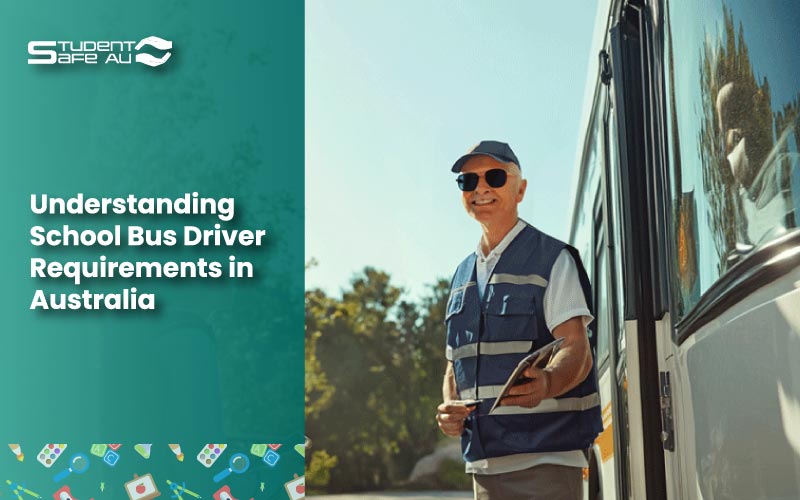Requirements and qualifications for school bus drivers in Australia.
Transporting students safely to and from school is a critical responsibility that requires specialised skills and knowledge. In Australia, driving a school bus is more than just holding a regular driver’s licence; it involves meeting specific requirements to ensure the highest safety standards for children. Understanding these bus driver requirements is crucial for educators and school administrators as they play a vital role in selecting the correct drivers and maintaining safety standards.
This article will explore the unique requirements for professional drivers who want to operate school buses in Australia. We will also discuss how partnering with Student Safe AU, a leader in safety management systems for Australian independent schools, can help schools obtain bus hire for education, optimise transport safety, and maintain high student transport standards.
1. Specialised Licences and Endorsements
One of Australia’s most essential requirements for school bus drivers is obtaining the appropriate licences. Unlike a standard car licence, school bus drivers must have a specific licence that allows them to operate a vehicle designed to carry many passengers. The type of licence required varies depending on the size and weight of the bus.
- Light Rigid (LR) Licence: Required for drivers operating buses with a Gross Vehicle Mass (GVM) of more than 4.5 tonnes but less than 8 tonnes and can carry more than 12 passengers.
- Medium Rigid (MR) Licence: Required for buses with a GVM greater than 8 tonnes and two axles.
- Heavy Rigid (HR) Licence: Required for larger buses with a GVM greater than 8 tonnes and more than two axles.
In addition to these licences, school bus drivers must also obtain a Driver Authority or a similar endorsement in some states. This accreditation certifies that the driver has met additional criteria for safely transporting school children.
2. Medical Assessments
A crucial part of Australia’s school bus driver requirements is passing regular medical assessments. Driving a school bus requires a high level of alertness and physical capability. As such, drivers must undergo periodic medical examinations to ensure they can handle the job demands. These assessments typically include:
- Vision Tests: Ensuring drivers have adequate eyesight to operate a bus safely.
- Hearing Tests: Testing a driver’s hearing capabilities to respond to sounds and alarms effectively.
- General Health Checks: Monitoring conditions like diabetes, heart health, and overall physical fitness to ensure drivers can perform their duties without risking the safety of their passengers.
Medical assessments help ensure that school bus drivers are in good health, which is vital for the safety of students.
3. Background Checks and Clearances
Safety is paramount when transporting school children; another critical aspect of the school bus driver requirements is thorough background checks. All school bus drivers in Australia must undergo a Working With Children Check (WWCC) or equivalent clearance in their state or territory. This check involves:
- Criminal History Checks: Ensuring that the driver has no criminal record, especially concerning offences involving children.
- Regular Renewals: These checks must be renewed periodically to ensure ongoing suitability for working with children.
These clearances help ensure that those entrusted with the safety of children are trustworthy and have a clean record.
4. Training and Certification
In addition to licences and clearances, school bus driver requirements in Australia also include specific training. Drivers must complete courses that cover:
- Safe Driving Practices: Understanding how to safely operate a bus under various conditions, including weather and road types.
- First Aid Training: Equipping drivers with the skills to handle medical emergencies until professional help arrives.
- Emergency Procedures: Training on how to respond to emergencies such as accidents, fires, or vehicle breakdowns to ensure the safety of all passengers.
These training programs prepare drivers for any situation, ensuring they can respond effectively to keep students safe.

5. Knowledge of Local Routes and Conditions
Another often overlooked aspect of school bus driver requirements is the need for a comprehensive understanding of local routes and traffic conditions. Drivers should be familiar with:
- School Zones and Traffic Laws: Understanding speed limits, pedestrian crossings, and other safety measures in school zones.
- Local Geography: Knowing the best and safest routes to take, especially during adverse weather conditions or roadworks.
This knowledge helps drivers make informed decisions to ensure safe and timely school transportation for students.
6. Ongoing Professional Development
Professional drivers must engage in continuous learning and development. This includes attending workshops, refresher courses, and safety drills to keep up-to-date with the latest safety protocols and driving techniques. Staying updated with the latest advancements in vehicle technology, road safety regulations, and emergency response strategies is an ongoing requirement.
Student Safe AU Supports Transport Safety
Ensuring that school bus drivers meet all these stringent requirements is just one part of maintaining safety standards in student transport. Schools must also have robust safety management systems in place. This is where Student Safe AU comes in.
Student Safe AU is a leading provider of safety management systems for Australian independent schools, offering innovative solutions that enhance transport safety and ensure compliance with all school bus driver requirements. Here’s how partnering with Student Safe AU can benefit schools:
1. Comprehensive Driver Monitoring and Training Tools
Student Safe AU provides schools with tools to monitor driver performance and ensure compliance with all school bus driver requirements. Our systems include GPS tracking, real-time driver behaviour monitoring, and automated alerts for deviations from safe driving practices. Additionally, Student Safe AU offers training resources to help drivers stay updated with the latest safety protocols.
2. Enhanced Communication and Emergency Response
Effective communication is critical in managing school transport safety, especially in emergencies. Student Safe AU provides advanced communication tools that enable quick coordination between drivers, school administrators, and parents. This ensures a rapid response to any issues, enhancing overall safety.
3. Customised Safety Solutions
Each school has unique needs, and Student Safe AU offers customised solutions tailored to those requirements. Whether ensuring compliance with local regulations or providing specific training programs for drivers, Student Safe AU helps schools maintain the highest safety standards.
Conclusion
Understanding and meeting the stringent school bus driver requirements in Australia is vital to ensuring the safety and well-being of students. Schools can maintain high safety standards by hiring qualified drivers, conducting regular checks, and providing ongoing training. Partnering with Student Safe AU further enhances these efforts, providing schools with the tools and support to optimise transport safety and meet all school bus driver requirements.
For more information on how Student Safe AU can help your school maintain transport safety standards and ensure compliance with school bus driver requirements, visit Student Safe AU. Together, we can ensure that every journey to and from school is safe and pleasant for all students.
